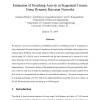Free Online Productivity Tools
i2Speak
i2Symbol
i2OCR
iTex2Img
iWeb2Print
iWeb2Shot
i2Type
iPdf2Split
iPdf2Merge
i2Bopomofo
i2Arabic
i2Style
i2Image
i2PDF
iLatex2Rtf
Sci2ools
124
Voted
VLSID
2005
IEEE
2005
IEEE
Estimation of Switching Activity in Sequential Circuits Using Dynamic Bayesian Networks
We propose a novel, non-simulative, probabilistic model for switching activity in sequential circuits, capturing both spatio-temporal correlations at internal nodes and higher order temporal correlations due to feedback. This model, which we refer to as the time coupled logic induced directed acyclic graph (TC-LiDAG), can be constructed from the logic structure and is shown to be a dynamic Bayesian Network. Dynamic Bayesian Networks are extremely powerful in modeling high order temporal as well as spatial correlations; it is an exact model for the underlying conditional independencies. The attractive feature of this graphical representation of the joint probability function is that not only does it make the dependency relationships amongst the nodes explicit but it also serves as a computational mechanism for probabilistic inference. We report average errors in switching probability of 0 006, with errors tightly distributed around the mean error values, on ISCAS'89 benchmark circ...
Computer Architecture | Order Temporal Correlations | Spatial Correlations | Spatio-temporal Correlations | VLSID 2005 |
Related Content
| Added | 01 Dec 2009 |
| Updated | 01 Dec 2009 |
| Type | Conference |
| Year | 2005 |
| Where | VLSID |
| Authors | Sanjukta Bhanja, Karthikeyan Lingasubramanian, N. Ranganathan |
Comments (0)

